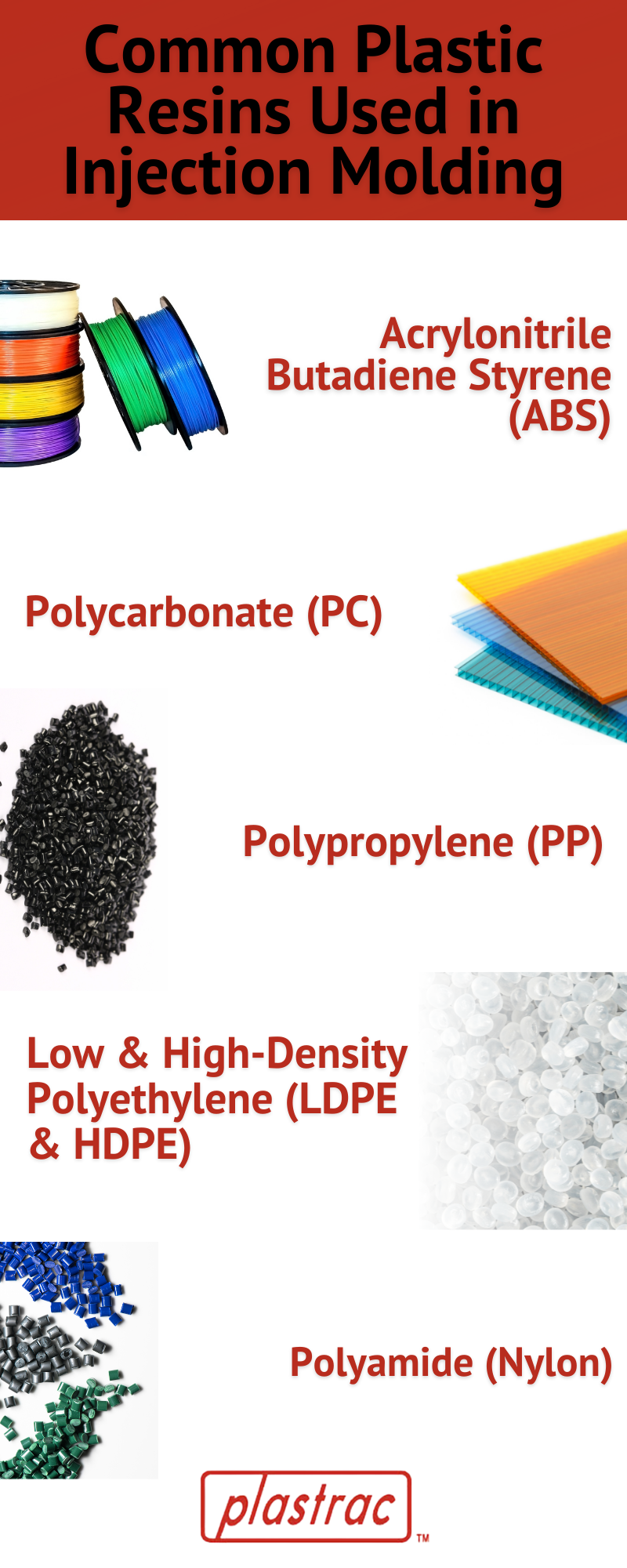Injection molding is a popular plastic manufacturing technique. It is widely regarded for its versatility, flexibility, cost efficiency, and precision. It is also well-known for its ability to work with multiple plastic resins simultaneously. Some plastic resins are easier to work with than others.
Here is an overview of five common plastic resins used in plastic injections:

Acrylonitrile Butadiene Styrene (ABS)
ABS has a range of superior properties ideal for working with injection molding. Essentially, ABS is lightweight, heat and impact resistant, durable, and tough. Its strength makes it especially popular with the automotive industry. It can also be designed into versatile and glossy designs, making it ideal for a wide range of applications.
Polycarbonate (PC)
Polycarbonate offers a blend of two unique and highly useful qualities: transparency and extreme strength. It can withstand high impacts and extreme heat, making it ideal for use with injection molding. It is also transparent, making it ideal for a wide range of applications, including bullet-proof glass, lenses, eyeglasses, DVDs, mobile phones, car parts, and a wide range of medical devices.
Polypropylene (PP)
Polypropylene is the most used plastic in the world. Its applications include packaging materials, automotive parts, electrical equipment, and everyday household appliances. It is especially popular for food packaging, as the polymer doesn’t leach carcinogenic chemicals into the food.
PP’s popularity is attributed to its many favorable qualities, including electrical resistance, heat resistance, stress resistance, high elasticity and versatility, and overall strength and hardness. Moreover, it can be used with a range of filters to make it even stronger and more versatile.
Low and High-Density Polyethylene (LDPE & HDPE)
LDPE is popular for use with everyday household items such as food packaging, toys, electrical wiring, computer components, medical products, agricultural produce, furniture, and household appliances. On the other hand, HDPE is ideal for food packaging and making everyday household items, and its most popular application is making water bottles.
LDPE is popular for its flexibility, high chemical resistance, moisture resistance, impact strength, and overall cost-efficiency. HDPE features all these properties at a higher level. Most importantly, HDPE is 100% recyclable, rendering it a sustainable option.
Polyamide (Nylon)
Polyamide, popularly known as nylon, also has applications across multiple industries all over the world. Its popular applications include automotive parts, medical devices, industrial tools, and sports gear, among others. It is popular for a range of properties, including extreme toughness, high resistance to electricity and chemicals, and high durability and stability.
Making the Best of Plastic Resins with Plastrac
At Plastrac, we design and manufacture volumetric and gravimetric blenders in addition to material loaders for all plastic processing endeavors. We have tailored our equipment to bring down the cost of processing plastics while maintaining efficiency. Get in touch with us today for more information about our plastic material blending products and accessories.
